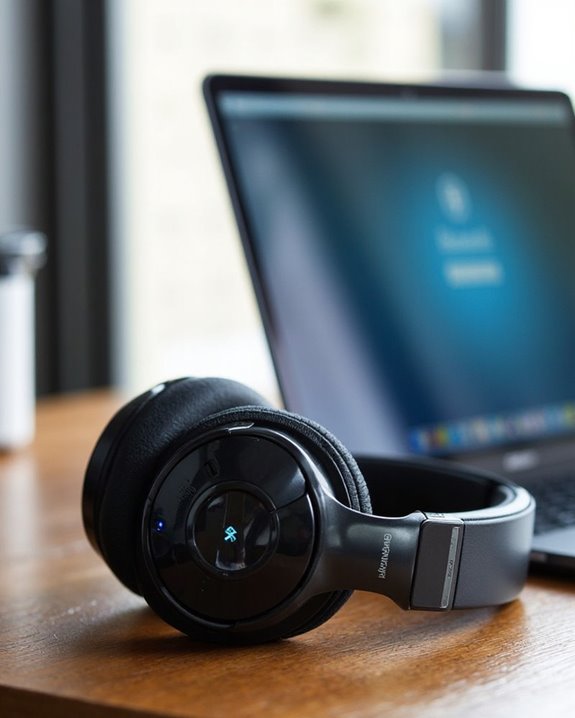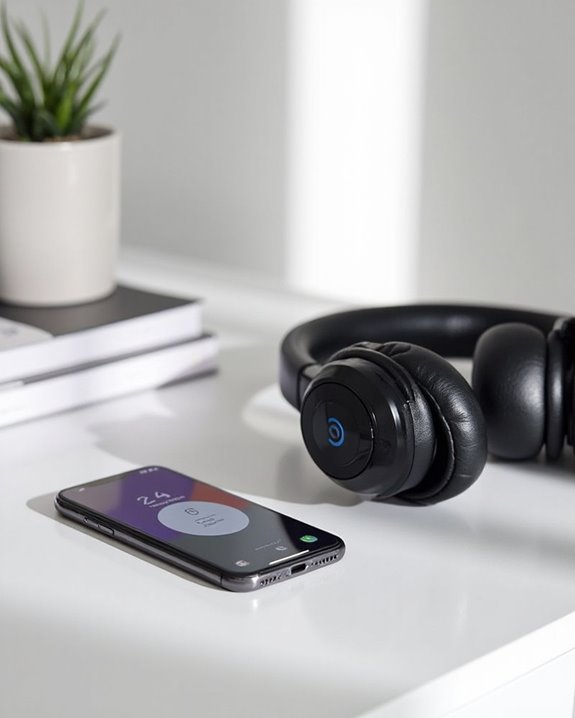Connecting headphones to a computer requires identifying the correct port first. Most computers have a 3.5mm headphone jack (often green) or USB ports for wired connections. For wired headphones, simply plug the connector into the matching port. Bluetooth headphones require enabling Bluetooth on the computer and activating pairing mode on the headphones. After connection, select the headphones as the output device in sound settings and adjust volume levels. Further configuration options enable enhanced audio experiences.
Key Takeaways
- Identify your computer’s headphone jack (typically green) or USB port before connecting your wired headphones.
- For Bluetooth headphones, activate pairing mode on your headphones and enable Bluetooth on your computer.
- After connecting, select your headphones as the default output device in your computer’s sound settings.
- Check physical connections and verify device recognition if you encounter audio problems.
- Update audio drivers through Device Manager (Windows) or system updates (Mac) to ensure compatibility.
Understanding Headphone Jack Types and Sizes
When connecting headphones to a computer, identifying the correct jack type is the first essential step toward proper audio connection. Most modern computers feature the standard 3.5mm jack (mini jack), whose Type Origins date back to the portable audio revolution of the 1980s. This format has become ubiquitous across consumer electronics.
The Size Evolution of headphone connectors reveals a trend toward standardization, with the 3.5mm jack dominating consumer devices while 6.35mm (1/4 inch) jacks remain common in professional audio equipment. The configuration of poles also matters greatly:
- TRS (Tip-Ring-Sleeve): Standard for stereo headphones
- TRRS (Tip-Ring-Ring-Sleeve): Used for headsets with microphones
For most computer connections, the 3.5mm stereo (TRS) configuration will suffice, though gaming headsets typically utilize TRRS to accommodate both audio and microphone functionality. Additionally, many of the best headphones compatible with computers use 3.5mm connectors for universal compatibility and ease of use.
Identifying Your Computer’s Audio Ports

Before attempting to connect headphones to any computer, users must correctly identify the available audio ports on their system. Most desktop computers feature color-coded audio ports on both the front and rear panels, with green typically designated for headphone output (line-out).
The port colors serve as a universal identification system: green for audio output, pink for microphone input, and blue for line-in connections. Users should note that laptops often have fewer, sometimes unlabeled ports.
Computers support different signal types through these ports. Analog connections use the standard 3.5mm jacks, while digital audio may travel through optical (TOSlink) connections, HDMI, or USB. Understanding these distinctions helps users connect their headphones to the appropriate port for best audio quality.
Many modern gaming headsets offer versatile connectivity options such as USB, 3.5mm, and wireless to ensure compatibility across multiple devices and platforms.
Choosing Compatible Headphones for Your System
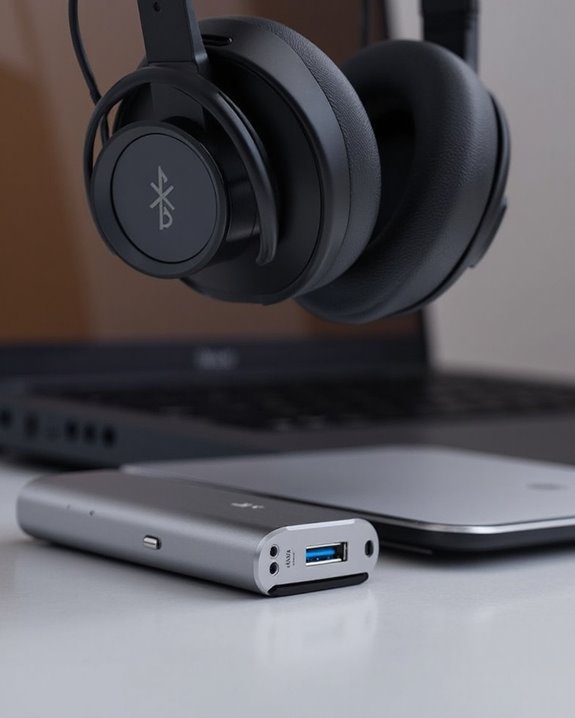
Selecting the right headphones for a computer system requires careful consideration of various technical factors to achieve best performance and compatibility. Users should prioritize established Brand Standards from manufacturers with proven track records in PC audio peripherals, guaranteeing reliable driver support and system integration.
When evaluating options, assess both connection types—wired models offer dependable, latency-free performance through 3.5mm or USB connections, while wireless options provide mobility but require compatible Bluetooth hardware. Different Use Cases demand specific features; gaming requires low latency and positional audio, while professional conferencing benefits from noise-cancelling microphones.
For ideal performance, verify that the headphones’ technical requirements align with the computer’s specifications, including operating system compatibility, port availability, and processing capabilities. This compatibility guarantees seamless functionality without additional adapters or configuration complexity. Many top gaming headsets also include advanced features like 7.1 surround sound to enhance the immersive experience.
Step-by-Step Connection Process
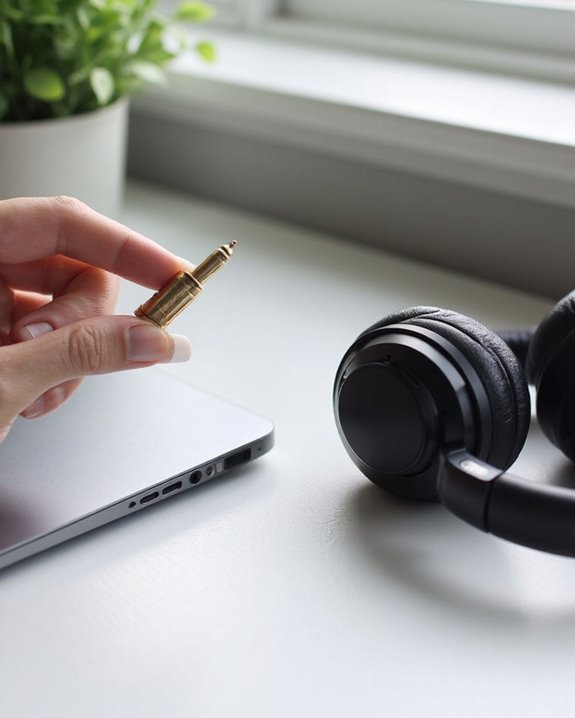
The step-by-step connection process follows logically after selecting compatible headphones, as proper installation guarantees peak performance of even the highest-quality audio devices. Device Unboxing should be done carefully, removing all packaging materials while preserving any included accessories like adapters or spare ear cushions.
Manual Review is essential before proceeding with any connections. For wired headphones, simply connect via USB or 3.5mm audio jacks to the corresponding computer ports. Bluetooth headphones require enabling Bluetooth on both devices, activating pairing mode, and selecting the headphones from available devices. Wireless headphones with USB receivers merely need the receiver plugged into an available port for automatic connection.
If issues arise, check for loose connections, verify audio output settings, update necessary drivers, or restart devices to resolve connectivity problems.
Configuring Audio Settings in Windows and Mac
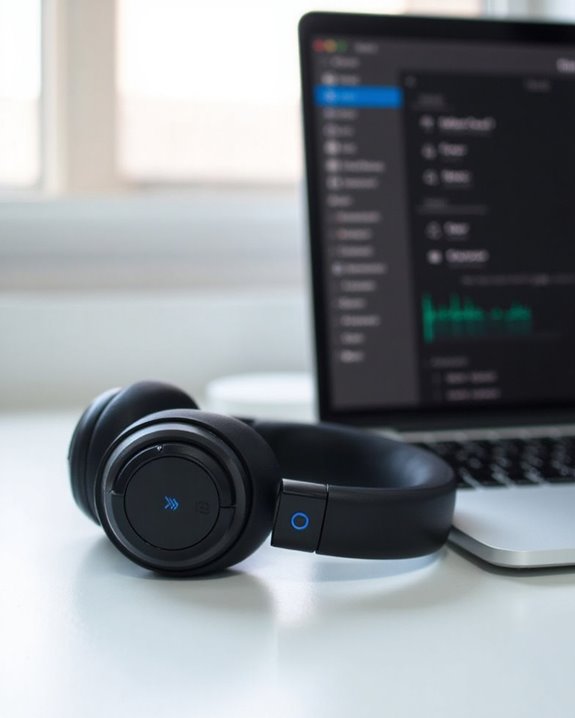
Once headphones are physically connected to a computer, properly configuring the audio settings guarantees best sound quality and functionality. In Windows, users should right-click the speaker icon in the taskbar and select “Open Sound Settings” to choose their headphones as the output device.
For Mac users, the process involves opening System Preferences, selecting Sound, and choosing the headphones in the Output tab. Balance Adjustment can be accessed through advanced settings in both operating systems, allowing users to fine-tune left/right channel volume for best stereo imaging.
Regular Driver Updates guarantee compatibility and performance improvements for audio devices. Windows users can manage these through Device Manager, while Mac automatically handles most driver updates through system software updates, maintaining best headphone functionality over time.
Troubleshooting Common Connection Problems
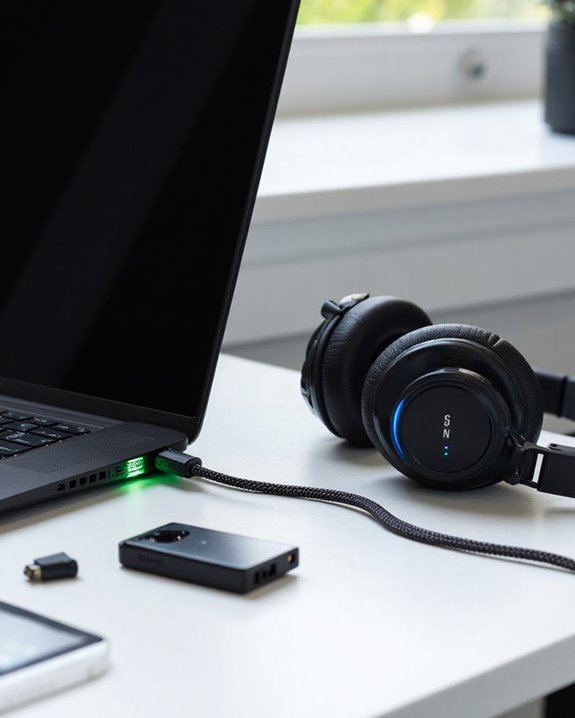
Despite following proper setup procedures, users may encounter connection issues that prevent headphones from functioning correctly with computers. When diagnosing problems, start with basic checks: inspect for physical damage, verify secure connections, and confirm proper power status.
For wireless headphones, Battery Troubleshooting is essential—confirm sufficient charge and replace batteries if necessary. Position headphones within the recommended Bluetooth range and implement Interference Solutions by moving away from competing wireless devices like routers or microwaves.
Software issues often cause connection problems. Check that headphones aren’t muted and are set as the default audio device in system settings. Outdated or corrupted drivers frequently disrupt connections, so updating audio drivers can resolve persistent issues.
For stubborn problems, try cleaning the headphone jack or restarting both devices to clear temporary glitches.
Using Adapters for Different Connection Types
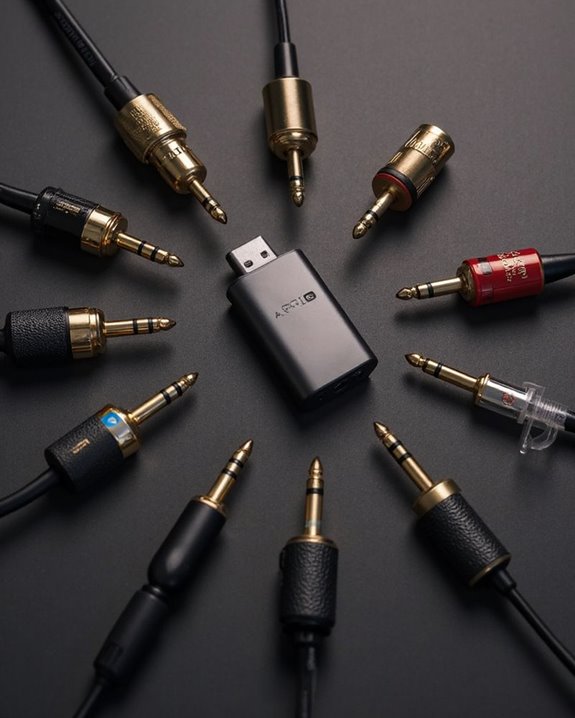
Handling the various connection types between headphones and computers often requires specialized adapters to bridge technological incompatibilities. Most computers feature either 3.5mm TRS jacks for standard headphones or USB ports for digital audio devices, but many headphones may use different connectors.
Common analog adapters include 3.5mm to 6.35mm (1/4 inch) converters for studio headphones, while digital scenarios might require USB-C to 3.5mm adapters for newer laptops without headphone jacks. Budget adapters are widely available starting at $5-10, though premium options with better shielding can reduce interference.
Adapter maintenance involves regular inspection of connector pins and cleaning with compressed air to remove dust. For ideal performance, users should store adapters properly and avoid excessive bending of cables, which can damage internal wiring.
Optimizing Sound Quality After Connection

After successfully connecting headphones through the appropriate adapter, achieving best sound quality becomes the next priority for computer users. Most operating systems offer built-in sound enhancement options accessible through device properties that can dramatically improve the listening experience.
Users should first verify they’ve selected the maximum sampling rate available, typically measured in hertz, to capture more audio detail. Activating Bass Enhancement features can add depth to music and gaming experiences, while Spatial Audio settings create a more immersive, three-dimensional soundstage.
For advanced customization, third-party equalizers like Equalizer APO allow precise frequency adjustments across multiple bands. System optimizations, including closing background applications and updating audio drivers, further guarantee consistent quality by eliminating potential interference and resolving compatibility issues.
Frequently Asked Questions
Can I Connect Multiple Headphones to One Computer Simultaneously?
Yes, multiple headphones can be connected to one computer simultaneously. Users can achieve shared listening through wired splitters or Bluetooth adapters, though connection limits may vary depending on the technology and hardware specifications used.
Will Connecting Headphones Damage My Computer’s Built-In Speakers?
Connecting headphones does not damage built-in speakers. Most computers utilize Speaker Muting technology that automatically disables speakers when headphones are plugged in. This Connection Safety feature prevents any potential electrical issues or hardware damage.
How Do Wireless Headphones Affect Battery Life on Laptops?
Bluetooth wireless headphones cause minimal battery drain on laptops. Power usage increases during connection maintenance and audio streaming. The impact varies by device, Bluetooth version, and usage patterns, but is generally less significant with newer technology.
Can I Use Gaming Console Headsets With My Computer?
As versatile as chameleons, gaming console headsets offer broad compatibility with computers. Most connect via USB, wireless dongles, or 3.5mm jacks. Some may require specific adapter types to guarantee full functionality with PC systems.
Do Bluetooth Headphones Cause Lag During Video Calls?
Bluetooth headphones typically introduce latency during video calls. This delay can cause audio-video misalignment. Call interference and connection quality may exacerbate Bluetooth latency issues. Using newer Bluetooth versions or low-latency codecs can help reduce these effects.

